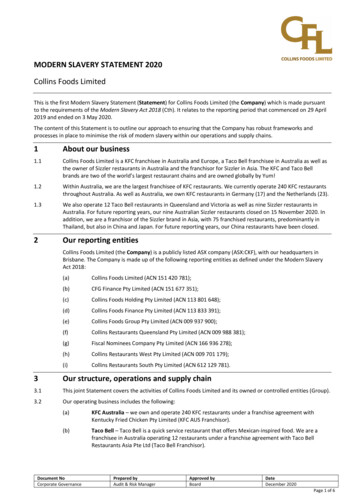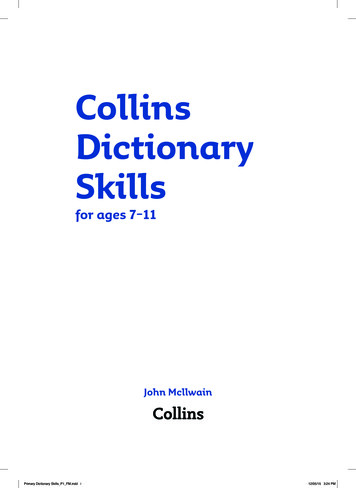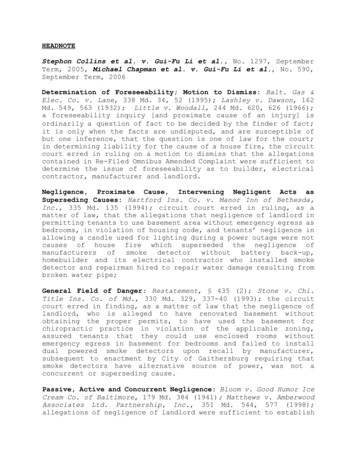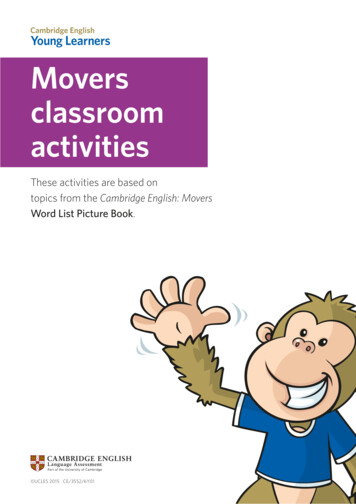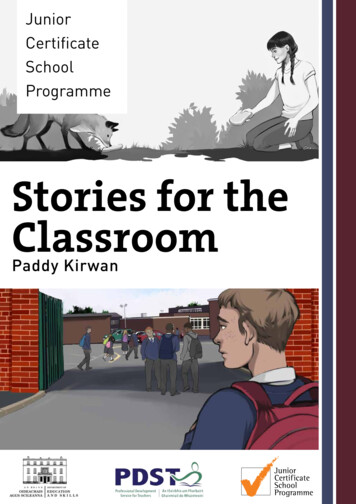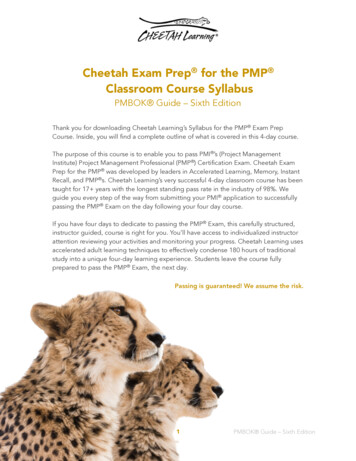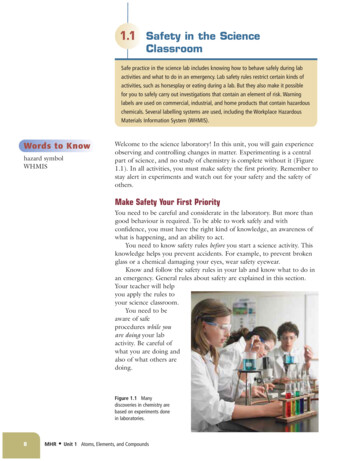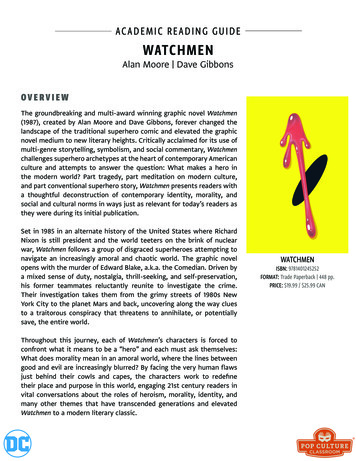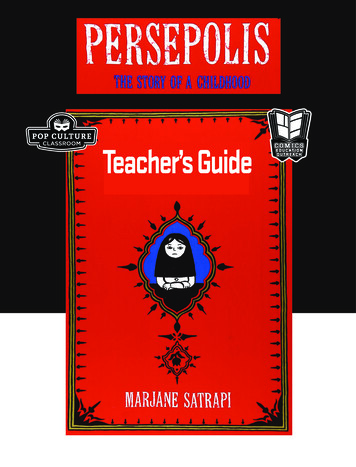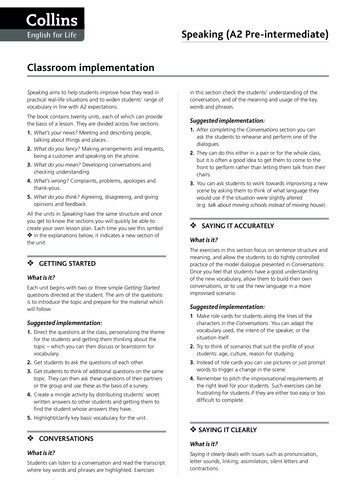
Transcription
English ReadersEnglish for LifeSpeaking (A2 Pre-intermediate)Classroom implementationSpeaking aims to help students improve how they read inpractical real-life situations and to widen students’ range ofvocabulary in line with A2 expectations.in this section check the students’ understanding of theconversation, and of the meaning and usage of the keywords and phrases.The book contains twenty units, each of which can providethe basis of a lesson. They are divided across five sections:Suggested implementation:1. What’s your news? Meeting and describing people,talking about things and places.1. After completing the Conversations section you canask the students to rehearse and perform one of thedialogues.2. What do you fancy? Making arrangements and requests,being a customer and speaking on the phone.3. What do you mean? Developing conversations andchecking understanding.4. What’s wrong? Complaints, problems, apologies andthank-yous.5. What do you think? Agreeing, disagreeing, and givingopinions and feedback.All the units in Speaking have the same structure and onceyou get to know the sections you will quickly be able tocreate your own lesson plan. Each time you see this symbol in the explanations below, it indicates a new section ofthe unit. GETTING STARTEDWhat is it?Each unit begins with two or three simple Getting Startedquestions directed at the student. The aim of the questionsis to introduce the topic and prepare for the material whichwill follow.Suggested implementation:1. Direct the questions at the class, personalizing the themefor the students and getting them thinking about thetopic – which you can then discuss or brainstorm forvocabulary.2. Get students to ask the questions of each other.3. Get students to think of additional questions on the sametopic. They can then ask these questions of their partnersor the group and use these as the basis of a survey.4. Create a mingle activity by distributing students’ secretwritten answers to other students and getting them tofind the student whose answers they have.2. They can do this either in a pair or for the whole class,but it is often a good idea to get them to come to thefront to perform rather than letting them talk from theirchairs.3. You can ask students to work towards improvising a newscene by asking them to think of what language theywould use if the situation were slightly altered(e.g. talk about moving schools instead of moving house). SAYING IT ACCURATELYWhat is it?The exercises in this section focus on sentence structure andmeaning, and allow the students to do tightly controlledpractice of the model dialogue presented in Conversations.Once you feel that students have a good understandingof the new vocabulary, allow them to build their ownconversations, or to use the new language in a moreimprovised scenario.Suggested implementation:1 Make role cards for students along the lines of thecharacters in the Conversations. You can adapt thevocabulary used, the intent of the speaker, or thesituation itself.2. Try to think of scenarios that suit the profile of yourstudents: age, culture, reason for studying.3. Instead of role cards you can use pictures or just promptwords to trigger a change in the scene.4. Remember to pitch the improvisational requirements atthe right level for your students. Such exercises can befrustrating for students if they are either too easy or toodifficult to complete.5. Highlight/clarify key basic vocabulary for the unit. CONVERSATIONSWhat is it?Students can listen to a conversation and read the transcriptwhere key words and phrases are highlighted. Exercises SAYING IT CLEARLYWhat is it?Saying it clearly deals with issues such as pronunciation,letter sounds, linking, assimilation, silent letters andcontractions.
English ReadersEnglish for LifeSuggested implementation:1. Find ways to bring the exercises off the page by makingyour own classroom materials from the content in thebook. See the sample lesson plans for units 1, 2 and 3 forsome ideas.Speaking (A2 Pre-intermediate) MY REVIEWWhat is it?2. Get students to challenge each other by recreatingquestions in the same format as the book. Monitorclosely.My review gives a list of can-do statements for the unit. Useit first and foremost as a way of checking that the studentsfeel comfortable that they have made progress in the classand can make these statements with some confidence.There are some additional ideas for its use below.3. Use reading aloud strategies to focus students on theparticular pronunciation issues highlighted in the section.Suggested implementation: SAYING IT APPROPRIATELYWhat is it?Saying it appropriately deals with issues of tone andintonation. The focus in Speaking A2 is on issues that areimportant to the lower-level student like politeness, andformality and informality.Suggested implementation:1. Use roles cards to switch situations between differentregisters or tenors (formal/informal, certain/uncertain,assertive/guarded).2. Find fast-moving games and activities like throwing abean bag to indicate it’s someone’s turn to speak.3. As above, you can use reading aloud strategies tofocus students on the particular pronunciation issueshighlighted in the section.1. Get pairs, small groups, or even the whole class tochallenge each other on the various can-do statements:Mikael, can you describe a person’s appearance?Yes, I can. I can talk about their height, or weight,the colour of their hair.Can you give me an example?Well, I can say someone is fat or overweight. Or, if Idon’t want to be rude I may say they are a bit plump.2. If students have performed a conversation of their ownmaking in the class and have a written record of it, getthem to identify the use of the can-do statements withintheir record.3. Always encourage students to keep an active record oftheir can-do achievements and follow up with you if theyare unsure. FEATURESWhat are they? GET SPEAKINGWhat is it?The exercises in Get speaking allow self-study studentsto make notes in preparation for a roleplay in which theyinteract with CD. The structure of most of the exercisesallows them to be easily translated to the classroomenvironment where their scope can be extended.Suggested implementation:1. Where the Get speaking activity assigns role to thespeakers, make roles cards for students (A and B).2. Get students to use the transcripts and suggestedanswers, in the back of the book, to either rehearse theirown ideas, or to check their improvisations.All the units contain feature boxes providing extrainformation and support for the content of the unit as awhole. These serve well as fillers if you have a few spareminutes during the lesson or for providing independenthomework ideas.Suggested implementation:1. Useful tips: These blues boxes appear at varying points inthe units and contain ideas for improving the students’speaking skills. Discuss the tip and decide whether itcould be useful in your students’ everyday lives.2. Language notes: These green boxes appear at varyingpoints through the units and contain additionalinformation about language from the Conversations.They can be used as a starting point for discussion,or to elicit further examples of the language identified.
English ReadersEnglish for LifeSpeaking (A2 Pre-intermediate)Classroom implementationSpeaking aims to help students improve how they read inpractical real-life situations and to widen students’ range ofvocabulary in line with A2 expectations.in this section check the students’ understanding of theconversation, and of the meaning and usage of the keywords and phrases.The book contains twenty units, each of which can providethe basis of a lesson. They are divided across five sections:Suggested implementation:1. What’s your news? Meeting and describing people,talking about things and places.1. After completing the Conversations section you canask the students to rehearse and perform one of thedialogues.2. What do you fancy? Making arrangements and requests,being a customer and speaking on the phone.3. What do you mean? Developing conversations andchecking understanding.4. What’s wrong? Complaints, problems, apologies andthank-yous.5. What do you think? Agreeing, disagreeing, and givingopinions and feedback.All the units in Speaking have the same structure and onceyou get to know the sections you will quickly be able tocreate your own lesson plan. Each time you see this symbol in the explanations below, it indicates a new section ofthe unit. GETTING STARTEDWhat is it?Each unit begins with two or three simple Getting Startedquestions directed at the student. The aim of the questionsis to introduce the topic and prepare for the material whichwill follow.Suggested implementation:1. Direct the questions at the class, personalizing the themefor the students and getting them thinking about thetopic – which you can then discuss or brainstorm forvocabulary.2. Get students to ask the questions of each other.3. Get students to think of additional questions on the sametopic. They can then ask these questions of their partnersor the group and use these as the basis of a survey.4. Create a mingle activity by distributing students’ secretwritten answers to other students and getting them tofind the student whose answers they have.2. They can do this either in a pair or for the whole class,but it is often a good idea to get them to come to thefront to perform rather than letting them talk from theirchairs.3. You can ask students to work towards improvising a newscene by asking them to think of what language theywould use if the situation were slightly altered(e.g. talk about moving schools instead of moving house). SAYING IT ACCURATELYWhat is it?The exercises in this section focus on sentence structure andmeaning, and allow the students to do tightly controlledpractice of the model dialogue presented in Conversations.Once you feel that students have a good understandingof the new vocabulary, allow them to build their ownconversations, or to use the new language in a moreimprovised scenario.Suggested implementation:1 Make role cards for students along the lines of thecharacters in the Conversations. You can adapt thevocabulary used, the intent of the speaker, or thesituation itself.2. Try to think of scenarios that suit the profile of yourstudents: age, culture, reason for studying.3. Instead of role cards you can use pictures or just promptwords to trigger a change in the scene.4. Remember to pitch the improvisational requirements atthe right level for your students. Such exercises can befrustrating for students if they are either too easy or toodifficult to complete.5. Highlight/clarify key basic vocabulary for the unit. CONVERSATIONSWhat is it?Students can listen to a conversation and read the transcriptwhere key words and phrases are highlighted. Exercises SAYING IT CLEARLYWhat is it?Saying it clearly deals with issues such as pronunciation,letter sounds, linking, assimilation, silent letters andcontractions.
English ReadersEnglish for LifeSuggested implementation:1. Find ways to bring the exercises off the page by makingyour own classroom materials from the content in thebook. See the sample lesson plans for units 1, 2 and 3 forsome ideas.Speaking (A2 Pre-intermediate) MY REVIEWWhat is it?2. Get students to challenge each other by recreatingquestions in the same format as the book. Monitorclosely.My review gives a list of can-do statements for the unit. Useit first and foremost as a way of checking that the studentsfeel comfortable that they have made progress in the classand can make these statements with some confidence.There are some additional ideas for its use below.3. Use reading aloud strategies to focus students on theparticular pronunciation issues highlighted in the section.Suggested implementation: SAYING IT APPROPRIATELYWhat is it?Saying it appropriately deals with issues of tone andintonation. The focus in Speaking A2 is on issues that areimportant to the lower-level student like politeness, andformality and informality.Suggested implementation:1. Use roles cards to switch situations between differentregisters or tenors (formal/informal, certain/uncertain,assertive/guarded).2. Find fast-moving games and activities like throwing abean bag to indicate it’s someone’s turn to speak.3. As above, you can use reading aloud strategies tofocus students on the particular pronunciation issueshighlighted in the section.1. Get pairs, small groups, or even the whole class tochallenge each other on the various can-do statements:Mikael, can you describe a person’s appearance?Yes, I can. I can talk about their height, or weight,the colour of their hair.Can you give me an example?Well, I can say someone is fat or overweight. Or, if Idon’t want to be rude I may say they are a bit plump.2. If students have performed a conversation of their ownmaking in the class and have a written record of it, getthem to identify the use of the can-do statements withintheir record.3. Always encourage students to keep an active record oftheir can-do achievements and follow up with you if theyare unsure. FEATURESWhat are they? GET SPEAKINGWhat is it?The exercises in Get speaking allow self-study studentsto make notes in preparation for a roleplay in which theyinteract with CD. The structure of most of the exercisesallows them to be easily translated to the classroomenvironment where their scope can be extended.Suggested implementation:1. Where the Get speaking activity assigns role to thespeakers, make roles cards for students (A and B).2. Get students to use the transcripts and suggestedanswers, in the back of the book, to either rehearse theirown ideas, or to check their improvisations.All the units contain feature boxes providing extrainformation and support for the content of the unit as awhole. These serve well as fillers if you have a few spareminutes during the lesson or for providing independenthomework ideas.Suggested implementation:1. Useful tips: These blues boxes appear at varying points inthe units and contain ideas for improving the students’speaking skills. Discuss the tip and decide whether itcould be useful in your students’ everyday lives.2. Language notes: These green boxes appear at varyingpoints through the units and contain additionalinformation about language from the Conversations.They can be used as a starting point for discussion,or to elicit further examples of the language identified.
English ReadersEnglish for LifeSpeaking (A2 Pre-intermediate)Unit 1: Meeting peopleSUMMARYYou can use this summary to guide the learning objectivesand target setting for your class.Can-do statementsBy the end of this unit, students will be able to say: I can use different phrases for meeting a friend andasking ‘how are you?’ I can use different phrases for meeting someoneI don’t know. I can use different phrases for introducing someone. I can ask suitable follow-up questions.VocabularyWork: job, meeting, internship, office, busy, companySchool: college, teaching, essay, classLife: journey, married, newsAppropriatenessFormal and informal registerGrammarQuestion tagsFunctionGreeting people: Great to see you. How are you (doing)?Lovely/Nice/Pleased to meet you.Introducing people: Karen, Ben. Ben, Karen. Let meintroduce Keeping the conversation going: How are things? Howare you finding it here? What’s your news.CLASSROOM EXTENSION IDEASYou can use some or all of these ideas to check andenhance your students’ understanding as they work theirway through Unit 1 of Speaking A2 in class.Using Getting startedYou can use the Getting started questions to prompt afind-a-match exercise.1. Make two photocopies of the find-a-match photographsbelow and cut them into individual pictures. You maywant to find more, other, better or more suitablephotographs for your students.2. Ask students to look at the main photo and ask themthe Getting started questions prompting responses like:they are friends, maybe they are at school, perhapsuniversity because they are casually dressed, they arelaughing and joking.3. Give each student one photograph, and tell them tokeep it secret. (Ensure that you have given out both pairsof identical photographs.)4. Students should get up and mingle around the roomdescribing their photograph (These are young people,they are in the park, ) until they think they have foundtheir partner. At this point they can compare photos tosee if they are right.Using ConversationsAfter Exercise 2, to test their full understanding, askstudents to work in pairs and find the phrases which gavethem the answers to questions 1–8.1. I’m getting married.2. I’ve got a new job.3. I have a meeting with Mr Williams.4. Yes, everything was fine, thanks.5. No, not yet. It’s really difficult.6. She’s in my sister’s class.7. She’s doing an internship.8. He runs our new office.The variety of short scripted conversations in these unitsgives students ample opportunity for tightly controlledpractice. After completing the Conversations section alwaysask the students to rehearse and perform one or other ofthe dialogues for the class. It is a good idea to get themto come to the front to perform rather than letting themdo it from their chairs. There are ten roles across the fourconversations here; you can repeat one scene more thanonce if you have more students, but there are plenty ofother opportunities in other units.Using Useful tip: introducing friendsYou can practice the intonation for this type of introductionwith a bean-bag throwing game. You can use a ball orwhatever you have that won’t hurt anyone!1. Model the intonation with the names of two students.Explain to students that the intonation often becomesmore pronounced because the grammar is omitted.Mario, Beatriz. Beatriz, Mario.2. Get students to stand in a circle.3. Throw the bean-bag to a student – Bo – and say:Bo, Louise. Louise, Bo.4. Bo then throws the bean-bag to Louise and says:Louise, Mina. Mina, Louise.5. Louise then throws the bean-bag to Mina, introducesMina to someone else, and so on.
English ReadersEnglish for Life6. Stop the game if the students are not getting theintonation right. Model it again before restarting.Using Language noteThe question tags in these conversations are confirmations(with falling intonation) rather than genuine questions.You can use the introduction of this grammar for a gameof question tag tennis.1. Explain the grammar as it is shown in the Languagenote box.2. Explain to the students that the speaker is using fallingintonation because they already know the answer, theyare just looking for agreement from the other person.3. Ask students to think of short statements like the onesthat precede the question tags in the Language note box(i.e. It’s very busy, and You didn’t like your old job, ).You will have to allow some time for this.4. Put students in pairs and get them to say a shortstatement to their partner. Their partner can then add thequestion tag. If they get it right, they can then reply witha short statement of their own; if they can’t think of areply, then the other speaker wins.5. Students can also play the game across the open classto any other student (like the bean-bag game above).You will probably need to rehearse the game with thestudents beforehand.Using Saying it appropriatelySaying it appropriately focuses on intonation for expressinginterest. After Exercise 2 and the Useful tip: meetingsomeone new, students can use this mingle activity to seeSpeaking (A2 Pre-intermediate)how interested they can sound in someone else’s life.1. Photocopy one Sounding interested question sheet,below, for each student.2. Brainstorm expressions for expressing interest (e.g.oh really?, fascinating, that’s great, me too, that’s reallyinteresting).3. Model them with an interested intonation and get thestudents to practise.4. Hand out the sheets and allow students time to fill inas many answers as they want – they don’t need to dothem all.5. Students can then get up and mingle with the otherstudents. Tell them to introduce themselves and talkabout the things they have written on their sheets.6. Other students should respond, expressing interestthrough their voice.Using My reviewActivate My review by getting pairs, small groups, or eventhe whole class to challenge each other on the variouscan-do statements.Beatriz, can you use different phrases for meeting afriend?Yes, I can. I can say How are you? and How are you doing?What about someone you don’t know?Well, Always encourage students to keep an active record oftheir can-do achievements and follow up with you if theyare unsure.
English ReadersEnglish for LifePHOTOCOPIABLESFind-a-match photographsSpeaking (A2 Pre-intermediate)
English ReadersEnglish for LifeSpeaking (A2 Pre-intermediate)Sounding interested question sheetI really likeI don’t like at all.I have a at home.My mother is aMy first job wasI can’tLast night II’m afraid ofI went to last year.Next year, I’m going toI really likeMy hero isI’ve always wanted to
English ReadersEnglish for LifeSpeaking (A2 Pre-intermediate)Unit 2: Describing peopleSUMMARYYou can use this summary to guide the learning objectivesand target setting for your class.Can-do statementsBy the end of this unit, students will be able to say: I can describe a person’s personality. I can describe a person’s appearance. I can use the schwa sound /ə/ correctly. I can use intonation to express approval anddisapproval.VocabularyAppearance: tall, odd, short, plumpPersonality: a good laugh, name-dropper, control freak,two-faced, know-it-allQualifiers: kind of , looks a bit AppropriatenessUse of negative expressionsPronunciation and intonationSchwa /ə/Linking soundsStress in positive and negative expressionsFunctionDescribing appearance: He’s kind of tall. She looks a bitodd.Describing personality: They’re a funny bunch. She’s gota heart of gold.CLASSROOM EXTENSION IDEASYou can use some or all of these ideas to check and enhanceyour students’ understanding as they work their waythrough Unit 2 of Speaking A2 in class.Using Getting startedYou can use the Getting started questions to brainstorm thestudents’ descriptive vocabulary.1. Bring one portrait photograph, from magazines or books,for each student, and attach them to a white sheet ofpaper so that students can write something on them.2. Ask the Getting started questions about the man in thephotograph at the top of the unit. You can elicit simplephysical description but also encourage the students touse their imagination (middle-aged, older, getting on,grey-haired, clean-shaven, likes to wear a hat, maybehe’s going bald, likes strong coffee, addicted to theinternet, lives in the country).3. Give students a photograph each and ask them toquickly add a description to it. They can give the persona name if they are stuck.4. When they have finished they can pass it on to the nextstudent who must add another description and so on.5. Monitor to help students who are struggling and stopwhen you feel the students are running out of ideas.6. At the point at which you stop, the picture the student isholding is their ‘friend’ and they must come to the frontof the class to introduce them to the rest of the class.This is my friend Hector. He’s .7. Encourage the other students to ask one or twoquestions at the end of each introduction.Using ConversationsThe variety of short scripted conversations in these unitsgives students ample opportunity for tightly controlledpractice. After completing the Conversations sectionalways ask the students to rehearse and perform one ofthe dialogues for the class. It is a good idea to get themto come to the front to perform rather than letting themtalk from their chairs. There are six roles across the threeconversations here; you can repeat one scene more thanonce if you have more students, but there are plenty ofother opportunities in other units.Using Useful tip: negative expressionsAt this point you may want to expand the students’receptive vocabulary of qualifiers – maybe they will start touse them in their roleplays.1. Read through the Useful tip: negative expressionsand ask students, in pairs, which speakers were moretentative in their views. Which speakers were carefulabout sounding rude? (Jon – looks a bit odd and Charlie– kind of short and a bit plump).2. Ask students if they can identify intensifiers in theconversations. Which speakers wanted to make theircomments stronger? Which words did they use? (Adam– very intelligent; Rosa – really strange and Charlie –so two-faced).Using Saying it accuratelyUse the students’ new vocabulary in a more improvised setting.1. Make sure the new vocabulary for physical andpersonality descriptions is on the board: (a bit odd, veryintelligent, a good laugh, funny, name-dropper, controlfreak, two-faced, has a heart of gold, smiley, know-it-all).2. Brainstorm more descriptions and add them to the boardtoo: (modest, kind, hairy, short-tempered, boastful,extrovert, easy-going, introvert, athletic, a bit of a Romeo).
English ReadersEnglish for LifeSpeaking (A2 Pre-intermediate)3. Get students to write them down on separate bits ofpaper and put them in a hat, bag or bowl, so that theycan be picked out at random.1. Photocopy the Get speaking roleplay cards below.4. Get a student to come to the front of the class and say tothem: Tell me about your boss.3. Let students practise in pairs before performing the scenefor the whole class.5. Let the student reach into the ‘hat’ and take a descriptionand speak: Well, he’s short-tempered. Last week he Using My review6. Try to get the student to come up with one example ofbehaviour and prompt them if necessary.7. Encourage the use of the qualifiers: Well, he’s a bitshort-tempered.8. You can ask the same student about someone else,move on to another student, or get pairs of students toperform this activity more like a roleplay conversation.Using Get speakingIn the book, Get Speaking is a roleplay activity that self-studystudents perform with the CD, but the classroom environmentallows you the scope to make this an improvisation.2. Put students in pairs of A and B and give the student ineach pair the appropriate role card.Activate My review by getting pairs, small groups, or eventhe whole class to challenge each other on the variouscan-do statements.Mikael, can you describe a person’s appearance?Yes, I can. I can talk about their height, or weight, orthe colour of their hair.What about their personality – that’s harder?Well, I know some words like Always encourage students to keep an active record of theircan-do achievements and follow up with you if they areunsure.
English ReadersEnglish for LifeSpeaking (A2 Pre-intermediate)PHOTOCOPIABLESGet speaking roleplay cardsSTUDENT AYou are at a party talking to your friend. Ask about a male guest in the room. (partner speaks) Listen to the reply and acknowledge it. Now ask about a female guest. (partner speaks) Listen to the second reply and acknowledge it. Now ask if your friend knows the groupof people in the corner. (partner speaks) Listen to the reply and acknowledge it. Now ask if your friend knows the strangelooking group by the bar. (partner speaks) STUDENT BYou are at a party with a friend and he/she asks you about a male guest in the room.Say his name and then say two negative things about him, and explain your opinion. (partner speaks) When your friend asks you about a female guest, say her name, two positive thingsabout her, and explain your opinion. (partner speaks) When your friend asks you about a group of people in the corner, say two negativethings about them and explain your opinion. (partner speaks) When your friend asks you about a group of people by the bar, say two positive thingsabout them and explain your opinion.
English ReadersEnglish for LifeSpeaking (A2 Pre-intermediate)Unit 3: Talking about thingsSUMMARYYou can use this summary to guide the learning objectivesand target setting for your class.4. Students can then exchange their photographs and asktheir partner the questions.5. Feed back with the whole class.Can-do statementsUsing ConversationsBy the end of this unit, students will be able to say: I can talk about things with non-precise descriptions. I can use correct pronunciation to link words together. I can use correct stress to show exaggeration indescriptions. I can use uncertain intonation for non-precisedescriptions.1. After Exercise 1 in Conversations you can ask studentswhich photograph from Getting started (including theextra photos from the Getting started photographs sheet)matched each conversation. (Answers: a – the main unitphoto; b – the women looking at a dress; c – the couplewith tickets, globe and computer).VocabularyNon-precise quantities: loads of , tonnes of , many Non-precise qualities: greeny ,Qualifiers: kind of , sort of , pretty (good)GrammarCountable and uncountable nounsPronunciation and intonationLinking soundsUnstressed syllablesStressing exaggerated adjectives/adverbsRising intonation for uncertaintyFunctionDescribing quality and quantity: It’s a greeny colour.There’s lots of stuff to do here.Exaggerating: You’ve got hundreds of boxes here.Qualifying: It’s pretty nice. It’s a sort of storage box.2. The variety of short scripted conversations in these unitsgives students ample opportunity for tightly controlledpractice. After completing the Conversations sectionalways ask the students to rehearse and perform one ofthe dialogues for the class. It is a good idea to get themto come to the front to perform rather than letting themtalk from their chairs. There are six roles across the threeconversations here; you can repeat one scene more thanonce if you have more students, but there are plenty ofother opportunities in other units.Using the second Language noteIf you want to remind students about countable and
English for LifeEnglish Readers Speaking (A2 Pre-intermediate) Classroom implementation Speaking aims to help students improve how they read in practical real-life situations and to widen students’ range of vocabulary in line with A2 expectations. The book contains twent

